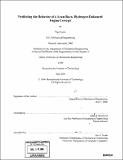| dc.contributor.advisor | John B. Heywood. | en_US |
| dc.contributor.author | Ivanic, Žiga, 1978- | en_US |
| dc.contributor.other | Massachusetts Institute of Technology. Dept. of Mechanical Engineering. | en_US |
| dc.date.accessioned | 2005-06-02T19:14:13Z | |
| dc.date.available | 2005-06-02T19:14:13Z | |
| dc.date.copyright | 2004 | en_US |
| dc.date.issued | 2004 | en_US |
| dc.identifier.uri | http://hdl.handle.net/1721.1/17932 | |
| dc.description | Thesis (S.M.)--Massachusetts Institute of Technology, Dept. of Mechanical Engineering, 2004. | en_US |
| dc.description | Includes bibliographical references (p. 90-91). | en_US |
| dc.description.abstract | (cont.) Lean operation of a spark ignition (SI) internal combustion engine (ICE) offers attractive performance incentives. Lowered combustion temperatures inhibit formation of nitrogen oxides (NOx), while reduced intake manifold throttling minimizes pumping losses leading to higher efficiency. These benefits are offset by the reduced combustion speed of lean mixtures, which can lead to high cycle-to-cycle variation and unacceptable engine behavior characteristics. Hydrogen-enhancement can suppress the undesirable consequences of lean operation by accelerating the combustion process, thereby extending the "lean limit." Hydrogen would be produced on-board the vehicle with a fuel reforming device. Since operating an engine in the lean regime requires a significant amount of air, boosting is required. Hydrogen is also an octane enhancer, enabling operation at higher compression ratios, which results in a further improvement in engine efficiency. The focus of this thesis is on the modeling aspect of the lean boosted engine concept. Modeling provides a useful tool for investigating different lean boosted concepts and comparing them based on their emissions and fuel economy. An existing architectural concept has been tailored for boosted, hydrogen-enhanced, lean-bum SI engine. The simulation consists of a set of Matlab models, part physical and part empirical, that have been developed to simulate performance of a real ICE. The model was calibrated with experimental data for combustion and emissions in regards to changes in air/fuel ratio, load and speed, and different reformate fractions. The outputs of the model are NOx emissions and brake specific fuel consumption (BSFC) maps along with the cumulative NOx emissions and fuel economy for the urban | en_US |
| dc.description.abstract | (cont.) and highway drive cycles. | en_US |
| dc.description.statementofresponsibility | by Žiga Ivanic. | en_US |
| dc.format.extent | 115 p. | en_US |
| dc.format.extent | 6314947 bytes | |
| dc.format.extent | 6314755 bytes | |
| dc.format.mimetype | application/pdf | |
| dc.format.mimetype | application/pdf | |
| dc.language.iso | eng | en_US |
| dc.publisher | Massachusetts Institute of Technology | en_US |
| dc.rights | M.I.T. theses are protected by copyright. They may be viewed from this source for any purpose, but reproduction or distribution in any format is prohibited without written permission. See provided URL for inquiries about permission. | en_US |
| dc.rights.uri | http://dspace.mit.edu/handle/1721.1/7582 | |
| dc.subject | Mechanical Engineering. | en_US |
| dc.title | Predicting the behavior of a lean-burn hydrogen-enhanced engine concept | en_US |
| dc.type | Thesis | en_US |
| dc.description.degree | S.M. | en_US |
| dc.contributor.department | Massachusetts Institute of Technology. Department of Mechanical Engineering | |
| dc.identifier.oclc | 56814709 | en_US |
